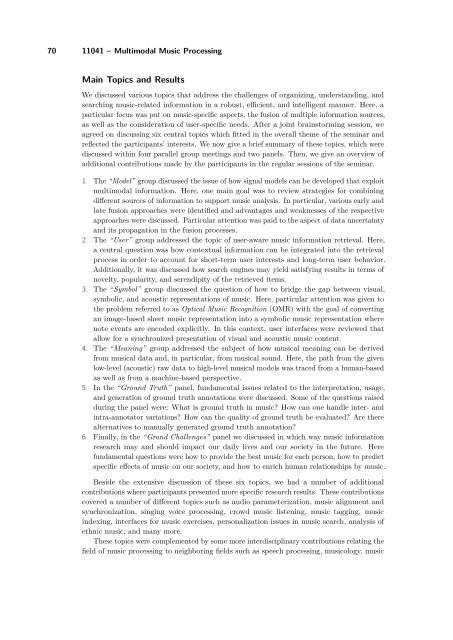Volume 1, Issue 1, January 2011 - DROPS - Schloss Dagstuhl
Volume 1, Issue 1, January 2011 - DROPS - Schloss Dagstuhl
Volume 1, Issue 1, January 2011 - DROPS - Schloss Dagstuhl
Create successful ePaper yourself
Turn your PDF publications into a flip-book with our unique Google optimized e-Paper software.
70 11041 – Multimodal Music Processing<br />
Main Topics and Results<br />
We discussed various topics that address the challenges of organizing, understanding, and<br />
searching music-related information in a robust, efficient, and intelligent manner. Here, a<br />
particular focus was put on music-specific aspects, the fusion of multiple information sources,<br />
as well as the consideration of user-specific needs. After a joint brainstorming session, we<br />
agreed on discussing six central topics which fitted in the overall theme of the seminar and<br />
reflected the participants’ interests. We now give a brief summary of these topics, which were<br />
discussed within four parallel group meetings and two panels. Then, we give an overview of<br />
additional contributions made by the participants in the regular sessions of the seminar.<br />
1. The “Model” group discussed the issue of how signal models can be developed that exploit<br />
multimodal information. Here, one main goal was to review strategies for combining<br />
different sources of information to support music analysis. In particular, various early and<br />
late fusion approaches were identified and advantages and weaknesses of the respective<br />
approaches were discussed. Particular attention was paid to the aspect of data uncertainty<br />
and its propagation in the fusion processes.<br />
2. The “User” group addressed the topic of user-aware music information retrieval. Here,<br />
a central question was how contextual information can be integrated into the retrieval<br />
process in order to account for short-term user interests and long-term user behavior.<br />
Additionally, it was discussed how search engines may yield satisfying results in terms of<br />
novelty, popularity, and serendipity of the retrieved items.<br />
3. The “Symbol” group discussed the question of how to bridge the gap between visual,<br />
symbolic, and acoustic representations of music. Here, particular attention was given to<br />
the problem referred to as Optical Music Recognition (OMR) with the goal of converting<br />
an image-based sheet music representation into a symbolic music representation where<br />
note events are encoded explicitly. In this context, user interfaces were reviewed that<br />
allow for a synchronized presentation of visual and acoustic music content.<br />
4. The “Meaning” group addressed the subject of how musical meaning can be derived<br />
from musical data and, in particular, from musical sound. Here, the path from the given<br />
low-level (acoustic) raw data to high-level musical models was traced from a human-based<br />
as well as from a machine-based perspective.<br />
5. In the “Ground Truth” panel, fundamental issues related to the interpretation, usage,<br />
and generation of ground truth annotations were discussed. Some of the questions raised<br />
during the panel were: What is ground truth in music? How can one handle inter- and<br />
intra-annotator variations? How can the quality of ground truth be evaluated? Are there<br />
alternatives to manually generated ground truth annotation?<br />
6. Finally, in the “Grand Challenges” panel we discussed in which way music information<br />
research may and should impact our daily lives and our society in the future. Here<br />
fundamental questions were how to provide the best music for each person, how to predict<br />
specific effects of music on our society, and how to enrich human relationships by music.<br />
Beside the extensive discussion of these six topics, we had a number of additional<br />
contributions where participants presented more specific research results. These contributions<br />
covered a number of different topics such as audio parameterization, music alignment and<br />
synchronization, singing voice processing, crowd music listening, music tagging, music<br />
indexing, interfaces for music exercises, personalization issues in music search, analysis of<br />
ethnic music, and many more.<br />
These topics were complemented by some more interdisciplinary contributions relating the<br />
field of music processing to neighboring fields such as speech processing, musicology, music













